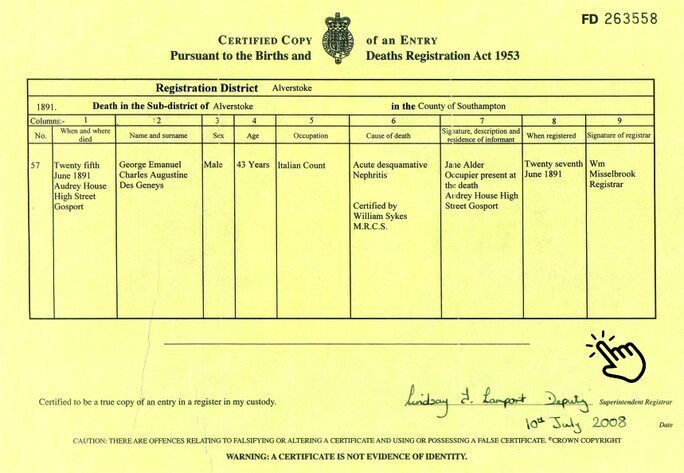
COUNT GIORGIO (GEORGE) EMMANUEL CHARLES AUGUSTUS DES GENEYS (1848 – 1891).
By Mary Duly
How did I get involved in researching the connection of George (to Anglicise his name) with Gosport?
An Italian, Dr. Graziella Martina, who is the archivist to the aristocratic family of a Count Ceriana of Pinerolo in Piedmont, asked me if I could throw any light on George, he being the last member of another branch of the Count’s family. George died a bachelor and so that line died with him on his death in Gosport in June 1891. Graziella learnt of my existence through the fact that we are both members of SERVAS, an international friendship organisation. She saw my name in the membership list and noted the fact that I am interested in genealogy and history in general, and thought perhaps I could help. She said that she had got nowhere through the usual channels.
To give some background - George’s family on both sides is distinguished.
On the Italian side, his grandfather, another Giorgio, was the founder of the Piedmontese Navy, the forerunner of the Italian Navy, in the early 19th Century. This older Giorgio’s 2 brothers also held important posts at the top of the Piedmontese administration. The family home is in Pinerolo in Piedmont, in the foothills of the Alps.
On the distaff side, his mother, Emily Eleanor, was a Baillie-Hamilton, the family name of the Earls of Haddington, with many links to other prominent Scottish and English aristocrats. The family home is Mellerstein, a famous Adams house in the Scottish Borders.
The Italian connection between the two families was forged through his father, Charles’ brother, George Baillie-Hamilton being Plenipotentiary (ambassador) to the Duke of Tuscany. This probably explains why his mother was in Florence in 1847, and had met and married the Count Des Geneys, (another Giorgio, and son of the Naval hero). Before I discovered the Uncle’s position I had at first thought that perhaps Emily was ‘doing’ the Grand Tour. Caroline, Emily’s sister, also married into an Italian aristocratic family.
Graziella gave me a few clues to start with. She knew that George was born in the registration district of Newton Abbot, and that he died in June 1891. From these bare facts I have been able to build up quite a biography, though some key facts have eluded me. She also gave me 2 books about the family. Although in Italian, they have provided photographs of the family, and the places associated with them. I have deposited these books in the Local History Section of the Discovery Centre, Gosport. George’s photograph makes clear that he was not a well, young man, He was only 43 when he died. Perhaps that explains why he came to live with a doctor: I later discovered from his death certificate that he suffered from a serious kidney condition.
‘My’ George’s father, another Giorgio, is recorded as an Italian naval officer as is ‘our’ George in future censi. The marriage bore 4 children, 3 daughters and one son - ‘Gosport’s’ George. The family were in Torquay, which lies in the Newton Abbot Registration Area, when George was born in 1848. I have acquired photographs of his birthplace, a fine house in the centre of Torquay, now used for administrative purposes. These facts I learnt from his birth certificate. I had hoped that the presence in the town in those rank-conscious days of such high born society folk would provide me with some reports in the local paper, but no such luck, those relevant pages are missing!
Sadly the father died in 1864, and the family, wife, Emily Eleanor, 3 daughters and George returned to England - remember the political situation in Italy at that time was very unstable, the Risorgimento campaign to unite Italy into one country was nearing its climax. The 1871 census reveals his mother and sisters to be settled in Hastings. George however came to live in Gosport, as I have already written, where he obviously had a very happy relationship with his hosts, Dr. and Mrs Alder.
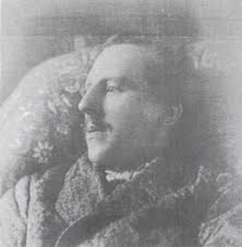 Then I worked on the date of his death – June 1891 featured in ‘The Hampshire Telegraph’ of July 7th 1891.
Then I worked on the date of his death – June 1891 featured in ‘The Hampshire Telegraph’ of July 7th 1891.I found a most interesting account of the funeral which completely overturned the stereotyped conceptions that I had had of an Italian aristocrat, that he would be a Roman Catholic and would be unlikely to have any connections with Freemasonry.
In fact, he had requested that the Rev. Lee, Vicar of Holy Trinity Church near Gosport Ferry should officiate at his funeral and that he be interred in the town cemetery on Ann’s Hill Road, a very Anglican ‘putting to rest’. Further, everyone noted as attending his funeral was a highly placed Freemason!
This gave me two lines of research: one, to find his grave, and two, investigate the Masonic connection.
Both lines have been fruitful.
Firstly, I was able to locate his grave in Ann’s Hill Cemetery. I then understood why he had requested to be buried there as the grave stands immediately behind that of his ‘hosts’ in Gosport, Dr Alder and Mrs Alder. From the Alder grave, I learnt that Dr. Alder died in 1888, 3 years before George, the wife later, after George in 1903. These facts seems to indicate a happy and positive relationship with his hosts.
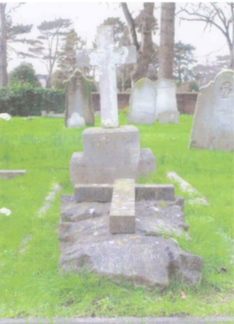 George was exhumed in 1905 and his body reburied in Pinerolo, the family base in Italy. I have photographs of all these graves. (2018. Sadly, the inscriptions on George’s grave are now illegible, fortunately not the case when I did this research) The second line of ’attack’ was to contact the Masonic Archivist, a Mr Steve Frost, at the Freemasons’ Hall in Clarence Road, Gosport. He was very interested and has been most helpful, the Masons having deliberately become less secretive at this time, than in former days. Mr. Frost showed me around the Hall and pointed out wall boards bearing George’s name and positions in the Lodge, also paper records too with George’s signature. From these, I have discovered the earliest date when I know he was in Gosport, to be 1877. He was a founder member of the prestigious Prince of Wales Lodge, which is still functioning. He was associated with more than this lodge.
George was exhumed in 1905 and his body reburied in Pinerolo, the family base in Italy. I have photographs of all these graves. (2018. Sadly, the inscriptions on George’s grave are now illegible, fortunately not the case when I did this research) The second line of ’attack’ was to contact the Masonic Archivist, a Mr Steve Frost, at the Freemasons’ Hall in Clarence Road, Gosport. He was very interested and has been most helpful, the Masons having deliberately become less secretive at this time, than in former days. Mr. Frost showed me around the Hall and pointed out wall boards bearing George’s name and positions in the Lodge, also paper records too with George’s signature. From these, I have discovered the earliest date when I know he was in Gosport, to be 1877. He was a founder member of the prestigious Prince of Wales Lodge, which is still functioning. He was associated with more than this lodge.I am still trying to find a reason, other than health, for George coming to Gosport in the 1870’s – was there some naval reason? A naval exercise? An attaché post? Anything to explain his arriving in Gosport, in the Portsmouth Command area with the census description of Italian naval officer? I have asked the Portsmouth Naval Museum, but it replied that it does not keep personnel records particularly of foreign nationals.
I have been able to ‘add some flesh’ to George’s life in Gosport from newspaper reports over the years which records, favourably, his being involved with local amateur dramatics with performances at Haslar Hospital given in order to raise funds for amenities for the patients. He gets credit for both his skills as a scenery painter and as an actor. His regular gifts to the Workhouse at Christmas are also noted.
About his hosts, the Alders … I wonder whether there might be some link through his mother with the Alders to explain George being their lodger for so many years. Mrs Jane Alder came from Doddington in Northumberland, not too far from Mellerstein, the Baillie-Hamilton home, which is just over the border in Scotland. Dr. Alder, an Irishman, had trained in Edinburgh. Could there be a connection somehow? This is my tentative hope!
Dr. Alder was a kind of M.O.H. in Gosport and had medical responsibilities for Army units when they came to the area on exercises.
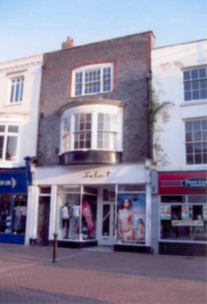 While the doctor was alive, they lived in Audley House at No.99 The High Street premises now in use as a dress shop. I was told that it has some interesting architectural features. After the doctor’s death Mrs Alder and George lived at 12 The High Street, which was bombed in the war.
While the doctor was alive, they lived in Audley House at No.99 The High Street premises now in use as a dress shop. I was told that it has some interesting architectural features. After the doctor’s death Mrs Alder and George lived at 12 The High Street, which was bombed in the war. 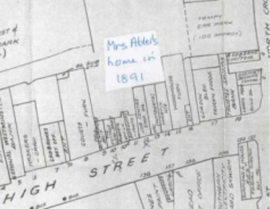 And I have no more to add, unless someone can suggest further ideas to research.
And I have no more to add, unless someone can suggest further ideas to research.I think Graziella is quite pleased, but I WOULD dearly like to know the missing key information – what actually brought him to Gosport to live with the Alders in the first place?
It has only in looking again at this information have I wondered whether George des Geneys and Jessie Meriton Mario nee White, a real star of Gosport’s history, and a heroine in Italy for her active support of the Risorgimento cause, have been aware of each other, both having a strong connection with both Gosport and Italy. She was born in Gosport and died in Italy, George Des Geneys, with an Italian father, spent most of his adult life in Gosport. I wonder if they met?

